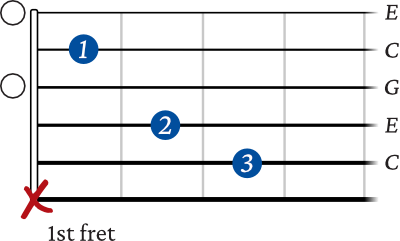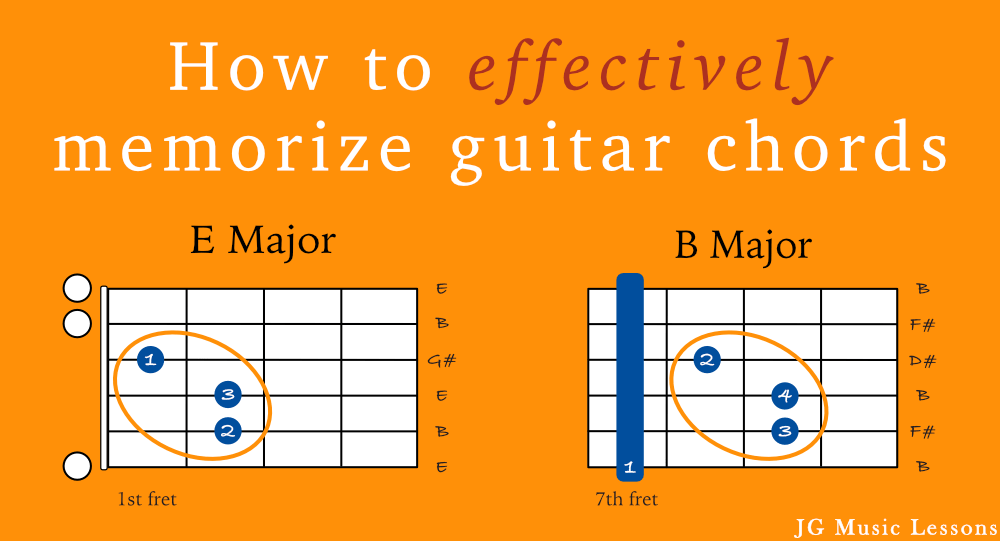Memorizing guitar chords is an essential skill for any guitarist. It allows you to play songs more smoothly and confidently, and to improvise and create your own music.
This guide gives you tips and techniques for effectively memorizing guitar chords quickly and easily!
Let’s get right into it!
Visualizing chord shapes for memorization
Before we get better at memorizing new chords, we need to master some essential chords that will give us a foundation for learning other chords across the fretboard.
To review some of the essential chords, you’ll see how we can visualize patterns for easier memorization. For example:
For an A Major chord, you can think of the phrase ‘straight A’s’ to remember that all of the fretted notes are on the same fret.

For a D Major chord, you can think of the shape of the letter for this chord. The three notes are spread out in a triangular like shape like this:

For a C Major chord, the shape makes me think of a staircase because the notes are laid out diagonally. In short, use any visual or phrase to remember a chord, whatever works best for you.

For some essential chords, it’s not as easy to define a strategy for visualization, so simply try to remember the shape, how many fingers your use, or how many times you play notes on a specific fret.
Here is another essential chord which we’ll use as a foundation for other concepts later in this lesson.

If you need to, feel free to review the first chords you should learn on guitar.
Adjusting for Major and minor chords
The key to adjusting for Major or minor chords is by knowing where the 3rd of the chord is! The 3rd of the chord defines a Major or minor chord quality.
The scale degrees 1, 3, and 5 make up a Major chord while 1, flat 3, and 5 make up a minor chord. Essentially, the 3rd of a chord is lowered by a half step to make up a minor chord.
For example, an E Major chord has the notes, E, G# (sharp), and B while an E minor chord has the notes E, G (natural), and B.
The key is to be able to locate that third scale degree in your chord shape. For example, notice that for the E, A, and D chords, the 3rd of the chord is on the last fretted note indicated in green.

To play these chords as minor, all we have to do is move the 3rd degree by a half step down.
Note that some fingerings for minor chords get rearranged so that it’s more comfortable to play.
Here is what these changes look like for each chord below.

Understand how chords are movable shapes
Once you have the essential chords down, we’re going to look at how we can move these shapes to play other chords across the fretboard.
We can shift chord shapes by using a barre chord, meaning you use one finger to cover multiple strings.
For example, see how the E and A chords can be shifted to other root notes by using a barre. Note that your fingers get rearranged when adding a barre, but the chord shape remains the same.
The chord charts below show the same chord shapes circled in orange.
Major barre chord shape 6th string

Minor barre chord shape 6th string

Major barre chord shape 5th string

Minor barre chord shape 5th string

Understanding this concept of movable chord shapes is the basis of where barre chords come from.
You can also review 5 tips to get better at playing barre chords if you are still having difficulty playing these chords.

Shifting movable shapes with any chord quality
As you progress and learn more advanced chords like 7th chords, you can apply the same concept of shifting movable chord shapes.
At first, you have to learn the specific shape of the chord but then you can play the same shape throughout the same string, starting on different root notes.
Here is an example of shifting a minor 7th chord shape across the 5th string to play different chords.

Know where the same notes repeat on the fretboard
By knowing which notes are in the middle of your fretboard, it’s much easier to find other chords throughout the fretboard.
We can think of these notes as our anchor points to shift to a specific chord, especially on the 6th and 5th string where many chords are often played.
To visualize this, see how the E and A notes repeat on the 6th and 5th string.

The open 5th string is an A note which is repeated on the 6th string, 5th fret and the open 6th string is an E note which is repeated on the 5th string, 7th fret.
If you know where these anchor points are, you can simply shift a chord shape relative to where those notes are on the lower strings.
If you still need help learning the notes on the fretboard, I recommend reviewing 7 tips to learn all of the notes on the guitar.
Chord chart memorization game
Memorization games are a powerful tool you can use to learn new chords. For example, choose four different random chords and write them out on these printable blank chord charts. You can adjust this number, but four chords is a reasonable amount to learn in one practice session.
First of all, the fact that you take the time to write these chords down will help you memorize the chord shapes better and you can review them later on.
For example, your chords practice game could look something like this:

After writing and playing each chord, flip the page and write the same 4 chord names down. Now, test your memory and try to recall each chord. Flip the page again when you’re ready to check your answer. Try not to glance at the other chords though! 🙂
You could play this kind of memorization game as a warmup to your practice sessions. I talk more about how to practice different music concepts in the 7 minute guitar practice routine.
Bonus tips for memorizing chords
- Find a time to learn when you are relaxed and mentally calm. I think the more tense or anxious you are, the less likely you are to remember new information.
- Consistency is key. Learning anything new simply takes repetition for it to become natural to you.
- Be patient with yourself. You may feel like you’re not improving but once you look back after a couple of months of playing, you’ll realize that you’re able to play things on your instrument that you couldn’t do before.
Wrapping up
Memorizing chords on guitar is a skill that gets easier as you understand and apply some music theory concepts we covered in this lesson. We also talked about visualization techniques to remember chord shapes more effectively.
Once you have the essential guitar chords down, you’ll be able to apply the chord shapes across the fretboard using barre chords. This will help you make more connections on your instrument which you might not have seen before.
Finally, you can use memorization games like the one mentioned here to learn and review guitar chords. The more often you repeat a specific chord, the quicker it becomes to remember the chord shape and what fingers you have to use.
If you want to expand your chord vocabulary, here are some suggestions:
- 6 different ways of playing a Major chord
- Spread triad chords on guitar
- Essential 7th chords on guitar
- Chord inversions on guitar
Level up the free guitar practice guide here!
All the best,
JG Music Lessons
Start Playing Better, Faster
with Pro Membership! ✨
Get the guidance, tools, and support that keep your progress on track:
🏁 Always know what to practice next. Access the full Guitar Learning Roadmap with lessons in sequence.
🎼 Play songs with confidence. Step-by-step lessons of popular, classical pieces and other styles.
📙 Save time and frustration. Clear PDFs and ebooks that save time so you can focus on playing.
🎟️ Get rewarded for consistency. 2 free downloads every month (a $240+ yearly value).
🎁 Keep costs low while you grow. 50% off all charts, tracks, and posters — up to 75% off bundles.
🚫 Stay focused. Ad-free environment keeps you in the zone.
💬 Get help when you need it. Direct member support to keep you on track.

